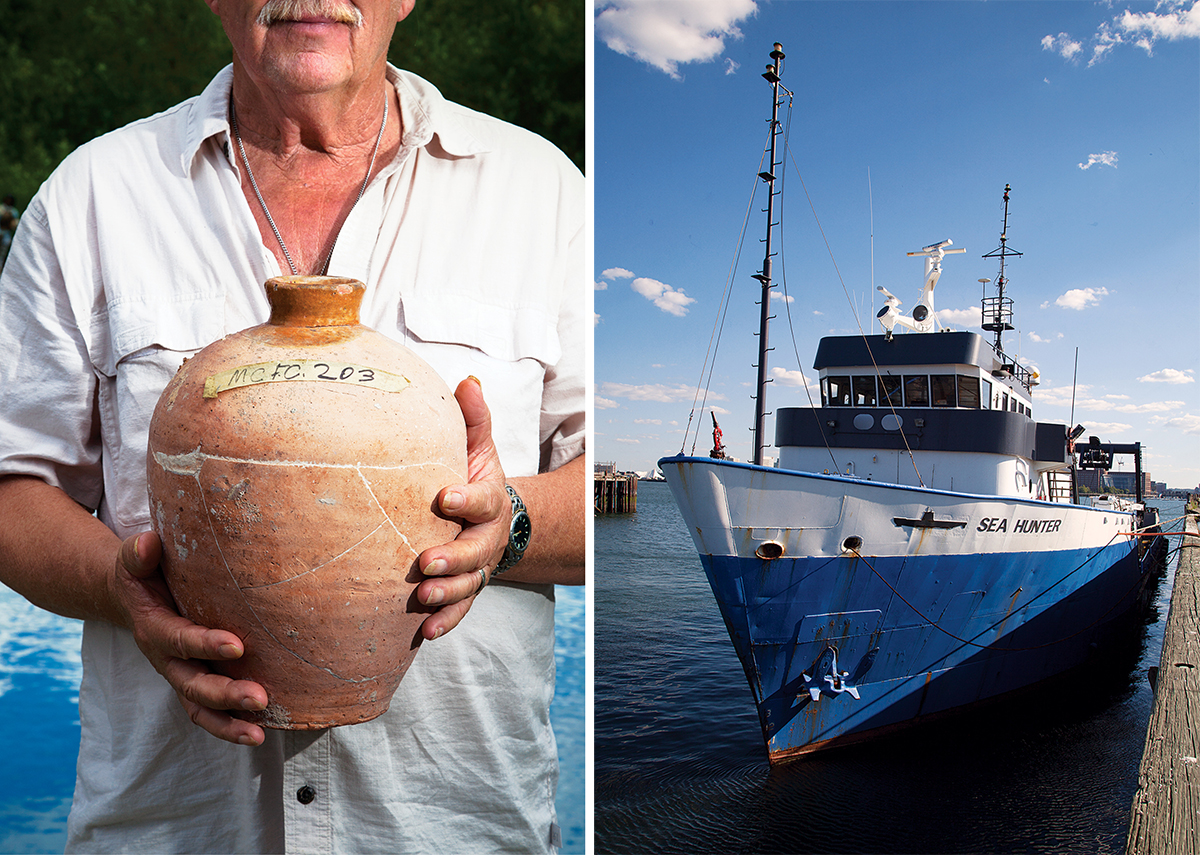Hook, Line, and Sinker

From left, Brooks holds a vase that he claims he recovered from a 1700s wreck in the Dominican Republic; his ship, the Sea Hunter, is docked in Boston Harbor. / Photographs by Dana Smith
On December 3, Brooks’s attorney filed a court brief that said Michaud had admitted to forging Port Nicholson documents. That may have given federal investigators probable cause to justify a raid. That very evening, agents got a magistrate in Portland to sign a search warrant for Brooks’s house, allowing them to look for evidence involving the Port Nicholson, Michaud, Brooks, and Brooks’s wife, as well as the possible “use of fraudulent historical documents for commercial purposes.”
The next morning, agents from the FBI, the National Archives’ inspector general, and the Maine State Police’s computer crimes unit showed up at Brooks’s door. “They came with all their automatic weapons drawn, and there was like five AR-15s and pistols [pointed] at me,” Brooks said. “They tore my fuckin’ house all apart.” During the raid, Brooks claimed, one agent confirmed that Michaud had worn a wire when he and Brooks spoke.
Brooks was adamant that he had nothing to do with any forgeries. He portrayed himself as a loyal friend disillusioned by betrayal. “Ed was my researcher for years and years, and I never had a reason to doubt him,” he said, even defending Michaud when lawyers questioned the documents. “I had to back him up, because I backed him up since day one, way back,” he said. “I trusted him.” Now, Brooks said, he thinks Michaud forged the documents in 2012 while trying to sell his share of the Port Nicholson’s promised riches. “I don’t think he made up anything previous to that,” Brooks said, “but I have to discount everything that he’s done, because you have to.”
If so, Brooks has to throw out nearly every claim he’s ever made about the Port Nicholson. His assertion that the Port Nicholson carried 1,707,000 ounces of platinum first appeared in his 2008 offering summary for investors. It was sourced to a 1957 National Archives document, “hard to access and rarely, if ever, consulted.” Shusta, who hired a researcher to check Brooks’s and Michaud’s claims, says the Archives have no such information, and he alleges that the offering summary deceptively misquotes a reference book that doesn’t mention the Port Nicholson at all.
And the deception appears to go even farther back. In 2003, as part of its salvage claim in Florida, Brooks’s company filed a summary of its purported historical research on the Notre Dame de la Deliverance with the federal court in Key West. Some of the historical information checks out—citations lead to history books that show a ship by that name sailed in the Atlantic in the 1740s.
But the citation for the claim that the Notre Dame sank in the Caribbean with Spanish riches aboard appears to be false. It’s sourced to a 1756 edition of the English maritime publication Lloyd’s List, supposedly located at the Phillips Library, in Salem. However, the library call number cited is incorrect, and a Phillips librarian says its Lloyd’s List collection doesn’t go back to the 1750s. The citation seems written to take advantage of a hole in the historical record; the most comprehensive microfilm collection of the publication is missing all issues from 1756. The date in the citation was a Thursday, a day when Lloyd’s List didn’t publish.
Brooks said Michaud also supplied most of the Notre Dame documents. “If that’s the truth, then he was doing this back then,” he said. “I’d like to kill the son of a bitch. Jesus Christ.”
Could Brooks, a 20-year veteran of treasure hunting, really have been fooled by Michaud’s forgeries for so many years? Did Brooks choose not to ask too many questions about stories that were too exciting to check? Michaud testified that Brooks paid him about $50,000 in 2012 alone. Was that for legitimate research—or for something else?
Michaud has never confirmed Brooks’s claim that he confessed to forgery, and in his 2014 depositions, he denied that the three Port Nicholson documents were forgeries. “He’s blaming the hired help,” Michaud said in a brief phone conversation this summer. “Typical. Look at who got all the money. I’m homeless. He’s not.” Michaud declined to comment further.
Warren Riess, an associate professor at the University of Maine’s Darling Marine Center, has followed treasure hunting with a skeptical eye ever since his friend, the late Peter Throckmorton, wrote a seminal 1990 paper about the industry, titled “The World’s Worst Investment.” Riess says treasure-hunting outfits often include two key figures, the “head person, a slick salesman, someone very good at lying,” and “somebody who’s taken a couple of history and archaeology courses” but is touted as the world’s expert on his research subject. “They make money selling stock, live high off the fat of the stock, don’t find much, and tell the press they find a lot,” Riess says. “Eventually—sometimes soon, sometimes after 20 years—they go bankrupt. They’ve had a great life—a house and boat and stuff. From the outside, it always looked to me like Brooks’s operation fit that.”
Brooks told me he hasn’t done anything wrong: “I’m a good guy, and all of a sudden I turn into a crook? And for what reason? I don’t have a friggin’ penny or a pot to piss in anymore.… What is the reason I would do it? For a job? I don’t think so.” Brooks said he’s broke, hasn’t gotten paid in two years, had to sell a boat he owned, is living off an inheritance from his mother-in-law, and is driving cars that are 10 years old or more. Furthermore, Brooks denies ever using the word “guaranteed” with any investor. He claims he was not at any of the meetings with the early investors from Gorham and that John Hardy Sr. recruited most of them.
Brooks gave me his 2008 offering summary for investors and noted that it warned about the Port Nicholson mission’s many risk factors. (Some investors say they received the document; others say they didn’t.) “The success of the search and/or recovery activities…is dependent…upon research and data,” begins the two-page risk-factor warning. “All such research and data regarding shipwrecks is imprecise, incomplete, and unreliable as it is often composed of…rumors, ‘legends,’ [and] historical and scientific inaccuracies.… Sub Sea [or] other parties the ‘Partnership’ hires to conduct research may fail to locate important pertinent documents,” the warning continues, or “may interpret them incorrectly.”
I asked Brooks to explain to me Kevin Lachance’s testimony that Brooks faked the gold brick. He laughed, doubled over, and slapped his knee theatrically.
“Oh, Jesus. Okay. Of course I can tell you about that.” He sat down next to me and looked me in the eye, really trying to communicate sincerity.
“We had a spy on the boat,” Brooks said. “Somebody giving away information and pictures.” That, Brooks said, is why he told crewmen he wanted to plant a gold bar on a wreck and film its recovery. As Brooks tells the story, the sting worked: In Brooks’s mind, Kevin Lachance exposed himself as the spy for the British legal team by revealing the fake-gold-bar scheme to the Deep Down lawyers.
On April 1, two months before I spoke with Brooks, a federal judge in Portland finally scuttled Brooks’s treasure hunt. There was likely “no valuable cargo to salvage” on the wreck, the judge’s opinion said, just “70-year-old truck tires, fenders, and miscellaneous other parts and military supplies.” The judge barred Brooks’s company from trying to salvage the Port Nicholson ever again.
Yet, unbelievably, Brooks insisted “circumstantial evidence” still points to treasure on the old tramp steamer. Why else, he asked, did the Port Nicholson’s convoy include five heavily armed escort ships? Why did the captain and chief officer reboard the freighter to try to save the cargo?
“We got information from all over the place, not just from [Michaud],” Brooks claimed. He started hunting for the Port Nicholson in 2006, he said, after receiving a tip from a mysterious Australian history researcher named Terry Kelly. I looked for Kelly, and unlike Jack McCann, he appears to have been a real person who wrote about a “handshake agreement” with Brooks on a treasure-hunting website in 2006. An Australian war-history website shows that Kelly salvaged World War II–era guns and airplane parts from a quarry outside Brisbane in 1992. The historian who runs the website told me Kelly died a few years ago. (Brian Ryder, a Sea Hunter crewman loyal to Brooks, backs up his boss’s stories about Kelly and the fake gold brick, though their accounts of the Kelly story differ. Ryder says Kelly named the Port Nicholson as the treasure ship, while Brooks says Kelly never named it.)
“I haven’t given up!” Brooks said. “I still believe that it’s on there. I almost believe it more now that it’s on there, because of all the fight that’s been thrown at me. I need to prove it one way or the other. All it takes is getting inside of it. It’s not over until I’m dead.”
The last artifacts from the Port Nicholson’s salvage reside in two plastic tubs inside a Portland law firm. “I can show you the great store of treasure,” says Michael Kaplan, one of the lawyers who represents the British. “It’s on the floor of my office.”
The tubs sit next to Kaplan’s bookshelf with a scribbled Post-it note marking them as the British government’s property. Kaplan opens them, revealing the sad, briny contents: rusty hatchets soaked in seawater, a cloth sieve, and a round cap or saucer of molded copper. It’s the only stuff salvaged from the Port Nicholson that the FBI didn’t seize from Brooks.
The FBI and National Archives investigations into the Port Nicholson affair are ongoing. The Maine Office of Securities is still interested in hearing from people who were approached about investing in Brooks’s treasure hunting. No criminal charges have been filed.
The MV Sea Hunter is moored at the Boston Harbor Shipyard & Marina in East Boston, short on money. A few loyal crew members still work on it, trying to keep it shipshape. Tour guides aboard the Boston Harbor Cruises now include the treasure-hunting vessel in their spiel. The ship is for sale on the website YachtWorld for $1.8 million, but if it sells, Deep Down, the company that sued Sea Hunters, will finally get paid for its 2012 mission. The company won a judgment for its entire bill of $134,000.
Brooks’ investors likely won’t be so lucky. Several say they’ve given up hope of seeing any of their money again.
Gary Auger, of Gorham, says that if he were to talk to Brooks now, he’d ask, “What’d you do with our money?” Auger thinks it’s unlikely that Brooks spent all of the $10 million on the cost of the failed salvage: “I think he spent a lot of it on himself.” He says Brooks once submitted an invoice to another investor for $30,000 to $40,000 for a “secret ROV operator.” When questioned about it, Auger says, Brooks claimed the “secret ROV operator” would be fired from his other job if his identity were exposed. Auger doesn’t buy it. “I think Greg took a chunk of change and put it in his pocket.”
Brooks says he never pocketed money and that the “secret ROV operator” is real. For about three years, Brooks says, he paid himself a salary of $1,000 to $1,500 a week, paid his wife $600 a week to handle bookkeeping and communications, and paid his daughter $500 a week to maintain a website and produce videos about the mission.
Shusta says vague record keeping about many transactions, including large cash withdrawals, makes it hard to know where the money went. “I think the motive is to live off other people’s money,” Shusta says. “I would describe what Greg Brooks does as a form of identity fraud. Greg wanted to fancy himself as a treasure hunter and salvage expert, and he really doesn’t know much about either. But he can talk a good story.”


